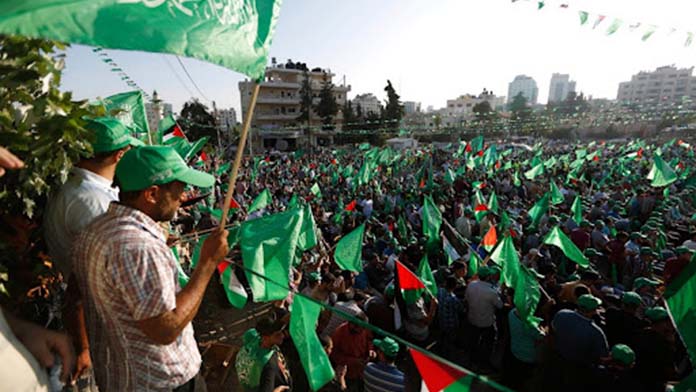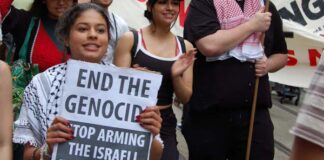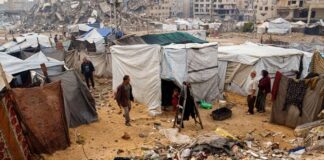Hamas grew out of the legitimate Palestinian resistance to Israel’s violence, writes James Supple, but its focus on armed struggle has not delivered liberation
Hamas has built wide support among the Palestinian population for resisting Israel’s occupation when other parties surrendered.
That’s because Gaza has faced decades of Israeli violence, occupation, and savagery.
Hamas won the last Palestinian elections held in 2006 with 74 out of 132 seats, and took control of Gaza shortly after.
A survey during the recent ceasefire in late November found 54 per of Palestinians in the West Bank and Gaza saw Hamas as most deserving of leading the Palestinian people, compared to just 13 per cent for its main rival Fatah.
Hamas was formed during the First Palestinian Intifada in 1987 as an Islamic resistance movement. It grew out of the Muslim Brotherhood, which had focused on charitable work in Gaza running schools and welfare services.
Although Islamic, it described itself as a “distinct Palestinian movement” and adopted the traditional approach of the main Palestinian nationalist organisation the Palestine Liberation Organisation (PLO), aiming to free the whole of historical Palestine from Zionist control through armed struggle.
This is a legitimate struggle for self-determination and freedom—both for the descendants of the 750,000 people who Israel ethnically cleansed and made refugees in 1948 and those in the West Bank, Gaza and East Jerusalem it has held under military occupation since 1967.
Hamas’ 1988 founding charter spelt out the group’s aims of uncompromising struggle against Israel’s occupation and a rejection of the idea that negotiations and concessions to Israel would deliver justice.
The document also called for an Islamic state and contained antisemitic tracts.
But as Hamas’ support grew it has shifted its views. When it ran in the 2006 Palestinian elections it presented itself as welcoming to Christians and appointed a Christian as one of its government ministers.
In 2017 Hamas released a revised charter, which dropped rhetoric about an Islamic state.
The document also made it clear that it was opposed to Israel and Zionism, not to Jewish people in general. It said, “Hamas does not wage a struggle against the Jews because they are Jewish but wages a struggle against the Zionists who occupy Palestine.”
Hamas support
Hamas won the Palestinian elections in 2006 at the expense of Fatah and the Palestine Liberation Organisation (PLO), who had led the Palestinian nationalist struggle for decades. This was the result of disgust and anger at their compromises and betrayals.
In 1993 the PLO had joined the Oslo Process, a series of negotiations with Israel that promised to deliver a Palestinian state in the West Bank and Gaza. The PLO renounced armed struggle and agreed to accept Israel’s control of the 78 per cent of historic Palestine that it seized in 1948.
It also agreed to collaborate with Israel, policing opposition to the occupation on its behalf. But the Palestinians received nothing in exchange.
Israel refused to offer them control even of the territories it had seized in 1967 as the basis for a state. Instead it continued expanding illegal settlements and taking over more Palestinian land, entrenching the occupation.
Israel has never been interested in peace with the Palestinians, except on terms of abject surrender and domination.
Hamas rejected the peace process as a sham from the beginning.
After Hamas won the 2006 elections Israel set out to destroy the new government, working with the US to arm the PLO, which it had beaten, to carry out a coup.
When Hamas took control of Gaza Israel imposed a brutal siege, restricting food supplies to just above levels that would cause starvation and saying it would “keep Gaza’s economy on the brink of collapse”.
This was a war crime that involved collective punishment of the entire civilian population.
Allowing in just enough aid to prevent the collapse of the Hamas government meant the Palestinians were left permanently divided, with the PLO taking control of the West Bank. This suited Israeli Prime Minister Benjamin Netanyahu because it provided an excuse for avoiding any kind of peace process or Palestinian state.
Hamas responded with the only means at its disposal—firing rockets into Israel in an attempt to force an end to the blockade.
Hamas offered a long term truce if Israel was willing to end the crippling blockade. But Israel continually refused.
As Israeli historian Avi Slaim has written, “Hamas has an impeccable record of observing ceasefires whereas Israel does not. Every ceasefire brokered by Egypt was violated by Israel when it outlived its usefulness.”
Instead Israel set out to unleash terror on Gaza regularly to keep it in a state of desperation.
Israel launched four major wars against Gaza from 2008 before the current assault.
Every time it deliberately targeted civilian areas. A major investigation by the UN Human Rights Council after the 2008 war described a pattern of war crimes and what it called, “a deliberately disproportionate attack designed to punish, humiliate, and terrorise a civilian population”.
Hamas has continued to defend the right of return of Palestinian refugees driven from their homes by Israel in 1948 and, at least rhetorically, the goal of liberating the whole of Palestine. Israel has responded with ruthless force at its refusal to offer complete capitulation.
But even before the 2006 elections Hamas had already made it clear it was prepared to accept a Palestinian state in the West Bank and Gaza as the basis for a long term peace.
It has reiterated this several times, including in its revised charter in 2017.
In doing so it was following the path taken by the PLO, and offering a major concession that acknowledged the limited power of armed Palestinian resistance to defeat Israel.
Armed resistance
After over four months of relentless bombing and invasion, Israel has failed in its aim to “completely destroy” Hamas. It is still unable to locate its key military leaders inside Gaza.
In recent weeks Hamas fighters have re-emerged even in Gaza City, despite Israel’s claim it had totally dismantled their fighting capacity there months ago.
In the face of the onslaught from Israel’s far more powerful military, simply surviving would be a victory of sorts.
But Hamas sees armed struggle as a route to Palestinian liberation. In January, it appealed for support saying that “the time has come” for the Arab states to send arms to the resistance, declaring that this was “not the battle of the Palestinian people alone”.
The Houthis’ attacks on Israeli shipping in the Red Sea have had some impact on Israeli trade. But even in the face of genocide, the other Arab states have done nothing to assist the Palestinians.
The United Arab Emirates, Saudi Arabia and Jordan are even helping Israel get around the Houthis’ attacks through setting up an overland route to deliver food, plastics, chemicals and electronics to Israel.
Their rulers are completely tied into the imperialist system in the region presided over by the US.
Even Hezbollah and Iran, the strongest forces in the so-called “axis of resistance” have been careful to avoid war with Israel. Iran too is more concerned with advancing its own power in the region, and sees an all out war with Israel as against its interests.
This demonstrates the weakness of armed resistance against Israel.
Trying to match Israel in terms of sheer military force is a dead end. It is the Middle East’s strongest power, with the full backing of the military superpower the US.
But mass struggle by workers and the poor could liberate Palestine. Struggle from below powered the revolt for national independence after the Second World War, and the Arab revolutions in 2011.
Mass revolt can topple the regimes that support imperialism and collude with Israel in places like Egypt, Jordan and Saudi Arabia.
Workers’ strike action also has the power to cause a crisis for the whole world economy. Workers could shut down the Suez canal, paralysing global trade. They could cut off the flow of oil on which whole national economies depend.
This would end Israel’s importance for US imperialism and force it to re-evaluate its backing for the Zionist state.
Making this a reality requires building socialist organisation across the Middle East, and organising to win workers to the fight for revolution.
Hamas is right to resist Israeli occupation
Israel and the Australian government constantly point to the Hamas attack on 7 October in an effort to justify the genocidal onslaught on Gaza.
But Palestinians have a right to resist Israeli violence and occupation—including through armed struggle. Israel is an occupying power that has dominated and oppressed Palestinians in the West Bank and Gaza for over 50 years.
Israel is responsible for all of the violence that has resulted.
Palestinians face humiliating restrictions on movement imposed by the Israeli military, which controls roads and checkpoints. Permits to work in Israel are frequently revoked, robbing Palestinians of jobs.
Israel has built over 150 official settlements in the West Bank and East Jerusalem that house 700,000 settlers, through slowly seizing Palestinian land and property. Since 2009 over 10,000 Palestinian homes and buildings have been demolished.
It runs a system of apartheid where Palestinians are denied all political rights.
While it evacuated its settlements in Gaza in 2005, Israel continues to control all movement in and out of the strip and has turned it into an open air prison.
Regular military raids terrorise the population, with 507 Palestinians including 124 children killed in the West Bank alone in 2023.
Israel uses extreme violence to crush all forms of dissent. During the First Intifada in 1987 then Defence Minister Yitzah Rabin ordered the military to break the bones of protesters. Today it prefers to shoot people in the knees to cripple them for life.
Resistance is fully justified.






